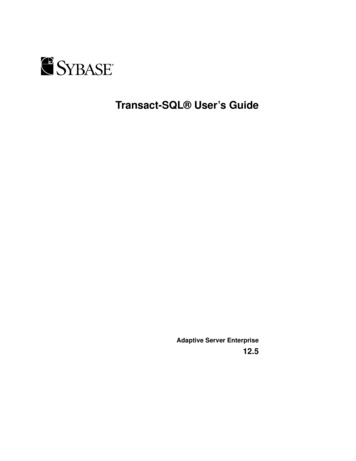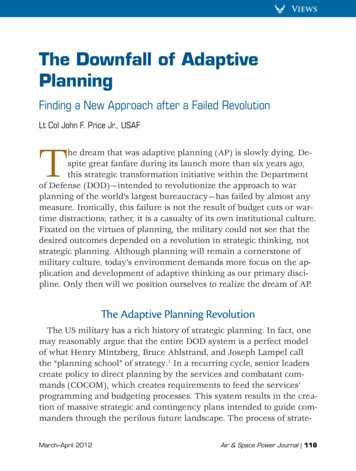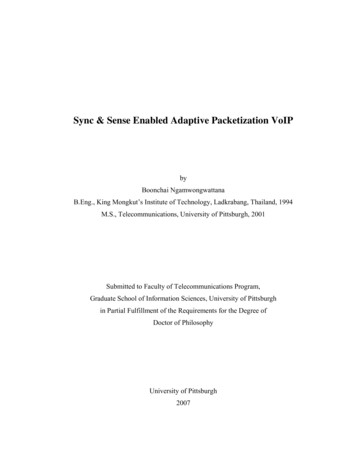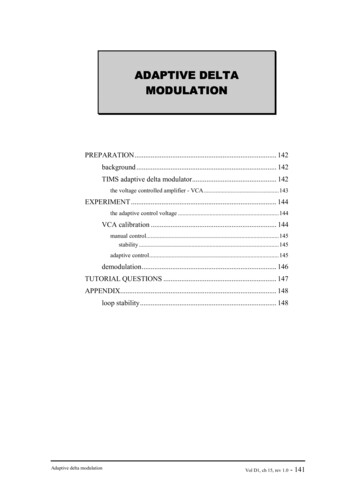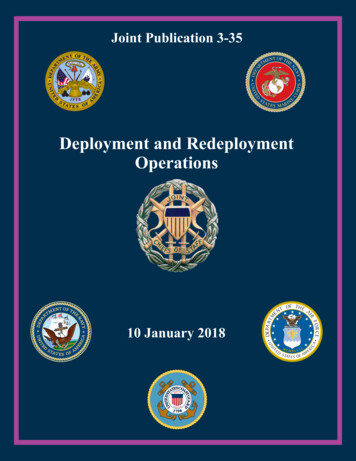
Transcription
ViewsThe Downfall of AdaptivePlanningFinding a New Approach after a Failed RevolutionLt Col John F. Price Jr., USAFThe dream that was adaptive planning (AP) is slowly dying. De spite great fanfare during its launch more than six years ago,this strategic transformation initiative within the Departmentof Defense (DOD)—intended to revolutionize the approach to warplanning of the world’s largest bureaucracy—has failed by almost anymeasure. Ironically, this failure is not the result of budget cuts or war time distractions; rather, it is a casualty of its own institutional culture.Fixated on the virtues of planning, the military could not see that thedesired outcomes depended on a revolution in strategic thinking, notstrategic planning. Although planning will remain a cornerstone ofmilitary culture, today’s environment demands more focus on the ap plication and development of adaptive thinking as our primary disci pline. Only then will we position ourselves to realize the dream of AP.The Adaptive Planning RevolutionThe US military has a rich history of strategic planning. In fact, onemay reasonably argue that the entire DOD system is a perfect modelof what Henry Mintzberg, Bruce Ahlstrand, and Joseph Lampel callthe “planning school” of strategy.1 In a recurring cycle, senior leaderscreate policy to direct planning by the services and combatant com mands (COCOM), which creates requirements to feed the services’programming and budgeting processes. This system results in the crea tion of massive strategic and contingency plans intended to guide com manders through the perilous future landscape. The process of strate March–April 2012Air & Space Power Journal 118
Viewsgic planning has obvious value, but its cumbersome, time-consumingnature puts it at odds with the demands of senior leadership at theturn of the century.Following the review and subsequent execution of Operation Plan1003V for the invasion of Iraq, Secretary of Defense Donald Rumsfeldexpressed his dissatisfaction with the output and pace of the existingplanning process. His guidance to find ways to conduct planning“quicker and better” led to development of the AP concept. On 13 De cember 2005, Secretary Rumsfeld signed out the Adaptive PlanningRoadmap 2005 to formalize implementation of a concept that had beenmaturing for several years.2 The first of what would soon become tworoad maps highlighted dissatisfaction with the existing system: “Thetraditional contingency planning process is insufficiently responsive tothe demands of today’s security environment.”3 To substantiate thisclaim, the road map cites the following shortfalls: xisting deliberate plans are difficult to implement, or adapt.E The 24-month deliberate planning cycle is too long and inflexible. . . . Plans do not incorporate sufficient branches and sequels. . . . Authoritative data is stovepiped [and] not readily accessible forplanning. . . . . . . No formal mechanisms [exist] to ensure early and frequent consulta tion among civilian and military leaders during plan development. . . . . . . Interagency involvement generally occurs very late in plan development.4To address these issues, developers intended AP to become “theJoint capability to create and revise plans rapidly and systematically,as circumstances require” (fig. 1).5 The idea called for identifying andaddressing significant roadblocks at the primary area of implementa tion—strategic plans divisions on the COCOM staffs—to allow produc tion of better contingency plans. This initial concept quickly morphedinto Adaptive Planning and Execution (APEX) in order to include boththe development and execution of plans.March–April 2012Air & Space Power Journal 119
ViewsGo from Here. to Here Sequential planning by echelon Periodic collaboration in physical space Near-parallel planning across echelons Continual collaboration in virtual spacet2 Years ( )6 mos (–)Detailed Feasibility AnalysisDone Late in the ProcessGo from Here.Branch Plan 1Base Plan(One Course of Action)Detailed Feasibility AnalysisDone Early in the Process. to HereOPLAN 9999AOPLAN 9999BOperation Plan(OPLAN) 9999OPLAN 9999CBranch Plan 2Single Course of Actionwith One or Two BranchesMultiple Courses of Actionwith Multiple BranchesFigure 1. What are we trying to do? (Adapted from Briefing, Andrew Hoffman,Joint Forces Staff College, subject: Adaptive Planning, February 2006.)March–April 2012Air & Space Power Journal 120
ViewsThe vision of AP was indeed revolutionary. Developers envisioned it“produc[ing] plans significantly faster, . . . and to a higher level of qualitythan is currently achievable” and “produc[ing] [relevant] plans withenough embedded options (e.g., branches and sequels)” designed forrapid execution.6 The grand dream involved “net-centric ‘living plans’ ”capable of rapidly reacting to “triggers” within a collaborative planningenvironment (fig. 2).7 Implementation of AP would use spiral develop ment that emphasized products, process, people, and technology (P3T),with the goal of reaching full operational capability in 2008. Unfortu nately, at the dawn of 2012, we can no longer recognize the originaltimetable, and we have little chance of realizing the grand vision in theabsence of significant changes.Fully mature adaptive planning will integrate situation monitoring,readiness, global force management, intelligence, planning, and ystemsServicesLogisticsSystemsGlobalInformation identof theUnited StatesDefenseStrategySecretaryof DefenseLogisticsSystemsDefenseTransportation TransportationSystemCommandMilitaryMilitary TrafficSealiftCommand ManagementCommandTheaterIntelCOCOM“Living Plans”NationalIntelNetworked on the GlobalInformation Grid in 2008USCoastGuardAlliedIntelJoint Commandand psFigure 2. The dream that never was: Vision for mature adaptive planning.(Adapted from Office of the Secretary of Defense, Adaptive Planning Roadmap 2005[Washington, DC: Office of the Secretary of Defense, 13 December 2005], 12.)March–April 2012Air & Space Power Journal 121
ViewsView from the Ground FloorAs a joint “Jedi in training” at the Joint Advanced Warfighting Schoolin 2005, I watched the emergence of AP with great interest. The basicidea of revolutionizing the joint operation planning process by usingtechnology and process improvements seemed ideal, especially since Iwould soon serve as a strategic planner at US Pacific Command, tack ling some of the nation’s toughest planning issues. However, despitethis interest, it was disconcerting to see that the content of the revolu tion seemed to concentrate solely on process, not purpose.All of AP’s tools emphasized increasing the speed of the same basicplanning process. Instead of realizing that the primary shortfalls of theexisting process stemmed from a lack of strategic thought, all effortssought to make the existing system work faster and provide more op tions. Rather than fundamentally questioning the entire process, de velopers assumed that it was correct and simply needed fine tuning.AP intended to optimize the presentation, writing, coordination, andsourcing of the massive plans but failed to address the most funda mental aspect of plan credibility—critical and creative thought.The military’s penchant for process and its fixation with planningdid not allow questioning of the most fundamental assumptions aboutthe chosen method for generating and delivering sovereign options.No one could challenge the presupposition that the vaunted militarydecision-making process would always deliver. In the end, the verycommunity that prides itself on the ceaseless examination of planningassumptions failed to critically examine the one assumption that couldhave saved the concept.The Fall of Adaptive PlanningOne can trace evidence of the downfall of AP back to the P3T changesdesigned to fuel the transformation. First, in the realm of personnel,developers acknowledged that AP “may overload planning staffs” withwork initially and “will require far more experienced planners” when itMarch–April 2012Air & Space Power Journal 122
Viewsmatures.8 However, a “comprehensive human resource strategy [wouldaddress] shortfalls in the selection, education, training, professionaldevelopment, and personnel management of Joint contingency plan ners.”9 Unfortunately, the “care and feeding” of the military planningcommunity has not changed, and the overload of planning staffs be came the only fulfilled promise of AP. Since 2005 the production of for mally trained planners has not increased. In fact, the decision to makethe sole joint planner training institution (the Joint Advanced War fighting School) only a senior developmental education school insteadof a dual junior-senior school saw an actual decrease in the effectivenumber of trained planners produced each year by the DOD.The products realm promised to expedite planning by using betterand timelier guidance to “generate plans with multiple branches andsequels . . . and alternate base plan[s].”10 Although this realm improvedslightly with the emergence of the documents Guidance for the Employment of the Force and Guidance for the Development of the Force to re place the Contingency Planning Guidance, they made no changes to thebasic approach to planning that the DOD has executed for decades.Massive, annex-laden plans continued to grow at the COCOMs whileentire war plans devolved into single PowerPoint slides for discussionsin Washington. In the end, the menu-of-options concept proved elusive.Of all these areas, the technology realm generated the greatest disap pointment, realizing only a fraction of the original grand design. APpromised to create “collaborative, . . . web-based planning technologyand tools with easily accessible, linked databases.”11 Instead, most ofthe tools intended to foster collaboration and reduce planners’ burdensnever materialized, and one of the proven sourcing tools—CollaborativeForce-Building Analysis, Sustainment, and Transportation (CFAST)—terminated prematurely in 2009.The final realm, process—ripe for improvement—should have expe rienced the most drastic change but produced only lackluster results.Formalization of in-progress reviews (IPR) between combatant com manders and the secretary of defense has enhanced the flow and fre March–April 2012Air & Space Power Journal 123
Viewsquency of plan reviews, but the 45-minute discussions of major strate gic concepts rarely brought about the advertised revolution in strategicguidance. No significant changes have occurred in plan development orreview processes, leaving the bulk of thought and effort to a small groupof planners on the COCOM staff. The promise of reducing the plan ning timeline from 24 months to “days” with the new process nevermaterialized (fig. 3). Indeed, the initial mandate of cutting the processin half—from a two-year development cycle down to one year—did notsurvive implementation and became significantly less stringent.Up to 24 Months or More for Deliberate PlanningPhase OneInitiationPhase TwoConceptDevelopmentCurrent ProcessPhase TwoConceptReviewPhase ThreePlanDevelopmentPhase OneSituationAwarenessPhase TwoPlanningPhase FourPlanReviewPhase FiveSupportingPlansPhase ThreeExecutionDays to Months for Crisis PlanningPrototype ProcessStep 1StrategicGuidanceReduces Planning Timefrom Months to Days (Deliberate)and from Days to Hours (Crisis)IPRsStep 2ConceptDevelopmentIPRsStep 3PlanDevelopmentIPRsStep 4PlanRefinementIPRsFigure 3. Comparison of adaptive planning process with current process.(Adapted from Office of the Secretary of Defense, Adaptive Planning Roadmap 2005[Washington, DC: Office of the Secretary of Defense, 13 December 2005], 19.)March–April 2012Air & Space Power Journal 124
ViewsBased on this review, even by the most generous standards, the APrevolution has failed. It did so because the complexity and duration ofthe strategic planning process resist simplification sufficient to accom modate the radical demands of agility and flexibility without significantrestructuring. To attain the desired outcomes, we must initiate a funda mental shift from sole reliance on a complex planning process to de pendence on strategic thinking and planning in a more agile framework.Strategic Planning versus Strategic ThinkingFor too long, US military circles have assumed that strategic plan ning and strategic thinking were synonymous. This premise, com bined with the military’s penchant for bureaucratic process, has led toplacing the preponderance of intellectual effort on the planning pro cess. Consequently, planners have endlessly pursued deeper anddeeper mission analysis, intelligence preparation of the battlespace,and excursions into effects-based operations in order to fine-tune thedevelopment, selection, and refinement of the course of action (COA).Even now as the planning community slowly embraces the latest fadof design, it still fails to understand that strategic planning and strate gic thinking are two distinct activities.Strategic planning, a process-based activity, focuses on analysis,logic, and procedures while strategic thinking, an idea-based cognitiveactivity, emphasizes synthesis, creativity, intuition, and innovation.12Strategic planning translates strategy into actionable content. Strategicthinking generates insight into the present and foresight regarding thefuture.13 It fuels the start of the strategic planning process but often be comes overwhelmed by concentrating on the next step in the processor by making PowerPoint slides for the next IPR. As T. Irene Sanderspoints out, “Most strategic planning models are still too complicatedand take too long; they are too confusing, too inflexible, and too dis connected from the dynamics of the real world context they are de signed to navigate. . . . Strategic thinking is often abbreviated or over looked completely.”14March–April 2012Air & Space Power Journal 125
ViewsThe military has long held that “it’s not the plan, it’s the planning.”Though typically employed to caveat the less-than-perfect results ofthe planning process, this quip actually points to the core issue thatpurposeful thought about the issues is more important than the pro cess or products. According to Jeanne Liedtka, “The ability of a strate gic planning process to deliver on its promise rests upon the quality ofthe questions it asks, rather than the answers it demands.”15 Strategicthinking keeps leaders in receive mode throughout the process, allow ing concepts to emerge and adaptation to occur along the way insteadof relying on the false expectation that everything is figured out in ad vance or will happen according to the planner’s timeline.Credible, Living Plans . . . with Options!AP transformation had the objective of creating credible, living plansthat provide multiple options to senior leaders. As someone who hasbeen intimately involved in the planning process, I know that this out come is possible only through a flexible, responsive framework andthe exercise of sustained critical thought. Only practiced strategicthought can provide the agility and creativity required to keep pacewith emerging threats while developing the menu of options neces sary to counter them.A great challenge occurs in the mesh of timelines between strategicthought, which operates continuously and on a scale of minutes andseconds, and strategic planning, which operates sequentially and on ascale of months and years. Members of the planning community resistcontinuous strategic thought because they cannot afford to keep the“good-idea window” open since doing so prevents completion of thatstep and delays movement to the next steps in the process. The inertiaof the planning process creates a natural resistance to embracing stra tegic thinking apart from its role at specific junctions in the process.The predictive nature of planning represents another significanthurdle for strategic planning as it pursues the adaptive goal. StrategicMarch–April 2012Air & Space Power Journal 126
Viewsplanning is plagued by what Mintzberg, Ahlstrand, and Lampel call“the fallacy of predetermination.” They write that “to engage in strategicplanning, an organization must be able to predict the course of its en vironment, to control it, or simply to assume its stability.” Mintzberg,Ahlstrand, and Lampel also observe that, effectively, “the world has tohold still while the planning process unfolds” and then unfold in themanner forecast.16 Since this scenario remains highly unlikely, thesecharacteristics seriously undermine the credibility, adaptability, andcurrency or “living” nature of the plans.A final set of barriers in the current system comes from underlyingstructures that comprise the strategic planning framework. The DODcontinues to use the Cold War–era Joint Operation Planning and Execu tion System (JOPES) to prescribe the format of its contingency plans.This colossal structure, described in Chairman of the Joint Chiefs ofStaff Manual 3122.01, Joint Operation Planning and Execution System(JOPES), vol. 1, Planning Policies and Procedures, 14 July 2000, prescribesnightmarish detail that leads to massive planning documents in excessof 1,000 pages. Added to this already unwieldy beast is an entire familyof plans that cascades down from the COCOM through service compo nents to the unit level and across to supporting commands such as USTransportation Command or US Strategic Command. These plans caneasily top tens of thousands of pages, and the sum total of this strategicplanning effort is about as agile as Mount Rushmore. Serious change inthis domain would require a direct confrontation with the “JOPESter”tribe who vigorously defends the system as the only part of planningthat works, failing to realize that JOPES is part of the anchor that pre vents institutional progress.If military leaders truly wish to reach their goal of having current,credible, and multiple options for confronting the threats that Americafaces, it is time to stop trying to breathe agility into the rigid planningprocess. Instead, they must generate agility and creativity by makingstrategic thinking our primary strategic discipline.March–April 2012Air & Space Power Journal 127
ViewsThinking AheadThe way ahead demands a return to the proper relationship betweenstrategic thinking and strategic planning. Both are vital to the continuedpreeminence of the US military, but if we wish to reach the originalobjectives of AP, we must turn our attention from strategic planning tostrategic thinking. This transition will neither occur overnight norprove easy because it will assail some of the long-standing culturalnorms and processes of the armed forces. However, the alternative isto continue using our outdated processes and live with products thatfail to meet the needs of the president and secretary of defense.Although this article does not presume to address all of the aspects ofthe proposed transition, five actions present themselves for consideration:1. Develop and strengthen strategic thinking skills. As a discipline, stra tegic thinking requires training and practice, as does strategicplanning; therefore, we should direct developmental efforts to ward accession sources and professional military education fo rums. At a minimum, specific training should include scanning(assess where we are), visioning (determine where we want togo), reframing (look at things differently), making common sense(translate what we “know”), and systems thinking (discern inter relationships and complexity).172. Expand the community. Unlike the relatively closed elite communityof strategic planning, the new strategic thinking culture shouldwiden its aperture. We will retain a select cadre of formally trainedplanners, but we can significantly expand participation in strate gic thinking to include more perspectives and creativity. Trainingand participation in the discipline of strategic thinking offer ben efits that go well beyond its strategic planning applications.3. Break the mold. Although still useful for static topics, the JOPESconstruct has outlived its utility for addressing the dynamic plan ning environment. We should eliminate the JOPES frameworkand replace it with streamlined requirements that allow creativityMarch–April 2012Air & Space Power Journal 128
Viewsand innovation to deliver options in the most appropriate and ex peditious format. In these days of remotely piloted aircraft andsatellite communications, we cannot allow our nation’s premierplanners to waste countless hours formatting planning documentsin Microsoft Word. Because the real measure of quality for a stra tegic plan lies in its content, not its format, we need to adopt anew method for capturing and presenting strategic thinking andplanning that reflects these priorities and our technological status.4. C hange the process. The current deliberate planning process needsmodification to reduce time and wasted effort. The most usefulaspect of the process occurs during mission analysis and COA de velopment, when most of the strategic thought occurs. Refocusingthe process at this point can provide greater coverage to multiplepotential futures since it does not force the selection of a singleCOA and saves significant time and resources. To offset thischange, COCOMs should institute regular crisis action planningreviews of their concepts since these processes bring the plansinto execution. These reviews will shape refinements or changesof the strategic concepts.5. “Red-team” the review. We must restore credibility to the plan-reviewprocess by completely overhauling the current administrativejoint planning and execution community (JPEC) review and in stalling a “red team” review. Although good in concept, the JPECoften amounts to little more than a haphazard collection of actionofficers across the DOD who possess neither the skills nor moti vation to effectively supply the intended review. Instead, COCOMplanners receive several hundred comments from the JPEC point ing out misspelled words on page 17 instead of substantive com ments on the operational design or logistical concept of operations.Socializing plans with the planning community will continue tohave value, but it is time to stop treating this as a validation pro cess. The red team, comprised of objective, experienced strategicplanners and thinkers, would critically review the underlyingMarch–April 2012Air & Space Power Journal 129
Viewslogic, creativity, and feasibility of the strategic concept while en hancing consistency in plan development.ConclusionThe objectives of the AP transformation effort are even more rele vant today than they were when the program began, but we stand littlechance of reaching them without significantly changing our approach.Even at this writing, the AP executive committee showed the dismalfuture of AP by terminating development of the “son of CFAST” suiteof planning tools and reducing IPRs for COCOM plans because theywere overwhelming senior leaders’ calendars. Meanwhile, our COCOMscontinue to struggle with insufficient numbers of trained planners,outdated planning tools, and an ever-increasing number of complexplans to maintain. We must acknowledge that the AP revolution hasfailed and shift our direction. As the dominant military intellectual dis cipline, strategic planning has served the DOD well, but it is not suitedto stand alone as the primary strategic mechanism because it lacks theagility and creativity to deal with the pace and diversity of today’sthreat environment. By emphasizing the development and employ ment of strategic thinking and moving away from the sluggish, con straining aspects of our planning structures, we can create current,credible options for addressing America’s security challenges. Notes1. Henry Mintzberg, Bruce Ahlstrand, and Joseph Lampel, Strategy Safari: A Guided Tourthrough the Wilds of Strategic Management (New York: Free Press, 1998), 49.2. Office of the Secretary of Defense, Adaptive Planning Roadmap 2005 (Washington, DC:Office of the Secretary of Defense, 13 December 2005).3. Briefing, Andrew Hoffman, Joint Forces Staff College, subject: Adaptive Planning, Feb ruary 2006.4. Office of the Secretary of Defense, Adaptive Planning Roadmap 2005, 2.5. Ibid., v.6. Ibid., 7.March–April 2012Air & Space Power Journal 130
Views7. Ibid., 8.8. Ibid., 23.9. Ibid., 24.10. Ibid., 22.11. Ibid., 24.12. Fiona Graetz, “Strategic Thinking versus Strategic Planning: Towards Understandingthe Complementarities,” Management Decision 40, no. 5/6 (2002): 457.13. T. Irene Sanders, Strategic Thinking and the New Science: Planning in the Midst of Chaos,Complexity, and Change (New York: Free Press, 1998), 10.14. Ibid., 137.15. Jeanne Liedtka, “Linking Strategic Thinking with Strategic Planning,” Strategy andLeadership 26, no. 4 (October 1998): 34.16. Mintzberg, Ahlstrand, and Lampel, Strategy Safari, 66–67, 68.17. Richard L. Hughes, and Katherine Colarelli Beatty, Becoming a Strategic Leader: YourRole in Your Organization’s Enduring Success (San Francisco: Jossey-Bass, 2005), 44.Lt Col John F. Price Jr., USAFLieutenant Colonel Price (USAFA; MS, National Defense University; MA,George Washington University; MA, Regent University) serves on the JointStaff, the Pentagon, Washington, DC. Previously, he served as a National Defense Fellow at the Massachusetts Institute of Technology, a C-17 squadroncommander, and a strategic planner at Headquarters US Pacific Command. Agraduate of Squadron Officer School, Air Command and Staff College, JointAdvanced Warfighting School, and Air War College, as well as an Air ForceFellow for Senior Developmental Education, Lieutenant Colonel Price is completing a doctorate in strategic leadership at Regent University.Let us know what you think! Leave a comment!Distribution A: Approved for public release; distribution unlimited.DisclaimerThe views and opinions expressed or implied in the Journal are those of the authors and should not be construed as carrying the officialsanction of the Department of Defense, Air Force, Air Education and Training Command, Air University, or other agencies or departmentsof the US government.This article may be reproduced in whole or in part without permission. If it is reproduced, the Air and Space Power Journal requests acourtesy line.http://www.airpower.au.af.milMarch–April 2012Air & Space Power Journal 131
Planning Phase Three Execution Phase Four Plan Review Phase Five Supporting Plans IPRs IPRs IPRs IPRs Current Process Prototype Process Figure 3. Comparison of adaptive planning process with current process. (Adapted from Office of the Secretary of Defense, Adaptive Planning Roadmap 2005 [Washington, DC: Office of the Secretary of Defense, 13 .


